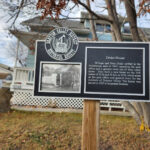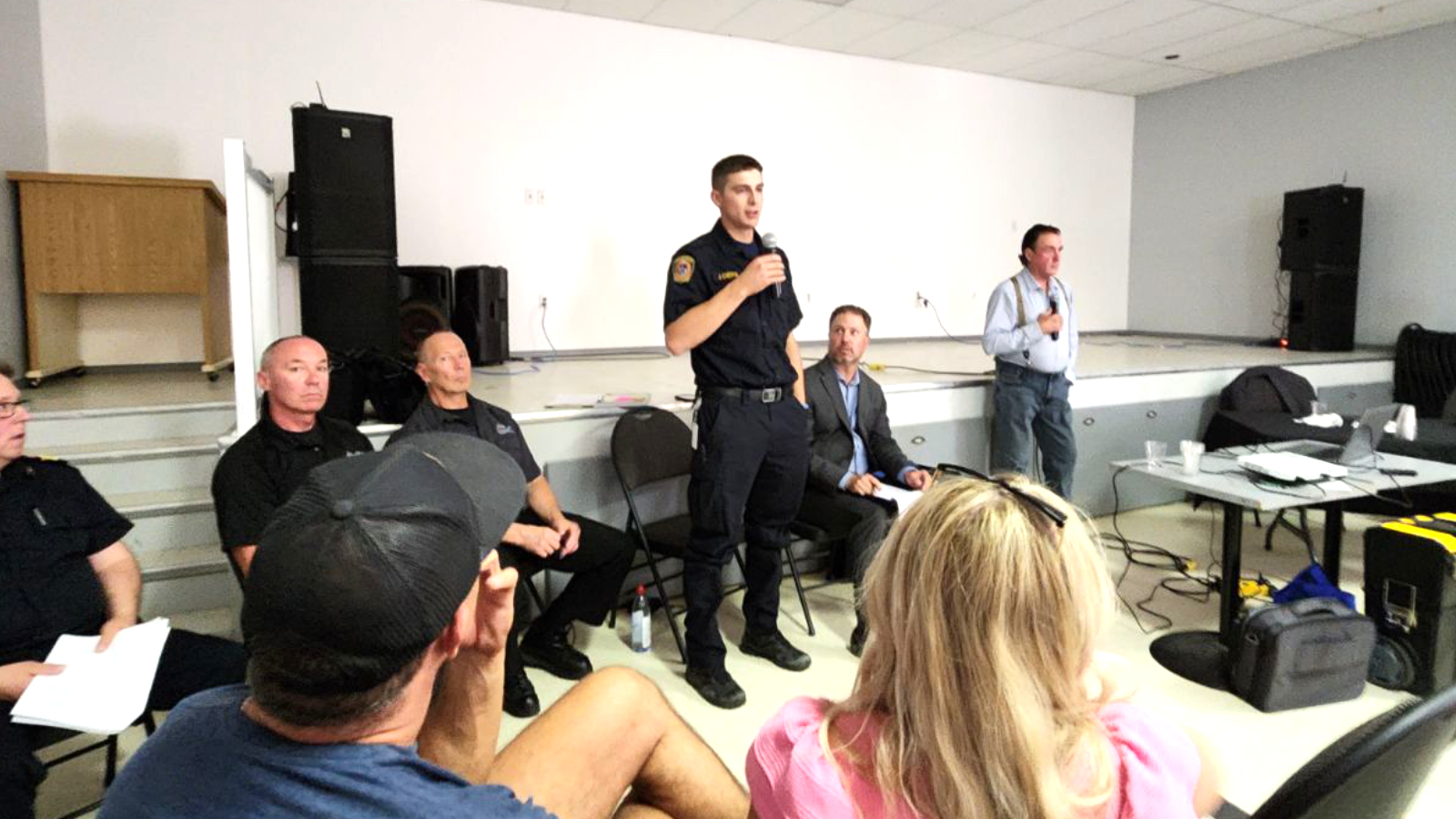Town and County residents who had concerns and questions about the Buck Creek fire got some answers on June 26 at a meeting at Buck Creek Hall.
The meeting was organized by Brazeau County and had all county councillors present, as well as members from the Drayton Valley Brazeau County Fire Services, representatives from the Alberta Emergency Management Agency (AEMA), the Drayton Valley RCMP, Town Mayor Nancy Dodds, and some town councillors.
Kent Edney, the chief administrative officer for Brazeau County, chaired the meeting. Using a powerpoint presentation, Edney gave a breakdown of the fire relief efforts and costs. He also used the presentation as an opportunity to address common questions the County has been receiving.
To help put things into perspective, Edney showed the classification of the fire. According to the AEMA, the fire was classified as a type 1 incident, which is the most complex type of incident that can occur. It typically requires national and sometimes international aid to address.
The fire itself was classified as Level 6 Head fire based on the Head Fire Intensity Scale, which is the most dangerous fire situation on a scale of one to six.
“So, you can see that even a trained firefighter isn’t going to run in front of that fire. They’re going to have to fight it from the back and the flanks,” says Edney.
Brazeau County Reeve Bart Guyon pointed out that the incident in Brazeau County sits in the same classification as other well-known natural disasters, like Hurricane Katrina.
“The complexity of responding to this fire was that same complexity of response for Hurricane Katrina,” said Edney.

All Saints Anglican Church
We participate in the Anglican Liturgy, which comforts and sustains us. Many have said that
However, at the time of the fire, there were 105 other wildfires in the province, and Edney said the Buck Creek fire didn’t make the top of the list of the most urgent.
“There were times when we were asking for 200 firefighters, but we only got 30,” said Edney of the first few days of the fire. The reality was that the resources in the province were spread thin.
Edney said there is a four-inch thick emergency manual they have to follow when something like this happens. This manual includes a very detailed command structure that has to be in place to help prevent confusion and misinformation.
Everyone fighting the fire only had one person to answer to at any given time. That person they reported to only had one person to report to, and this went all the way up to the Incident Commander.
In the system, no more than seven people answered directly to the commander. And each of those people only had seven people answering to them, all the way down to the boots-on-the-ground firefighters.
This command structure included the RCMP, fire department, Town, County, and eventually other groups who came in to offer aid. All directions came from one person to ensure there was a consistent effort.
Edney also gave a breakdown of the statistics of the event. In total, there were more than 12,000 acres affected by the fire, which had a perimeter of 48.1 km. He says there were five residences lost to the fire, but there were zero casualties. There were only two known injuries during the entire firefighting effort.
A new proposal could see the creation of a fire rescue college in Lodgepole.
In a presentation to Brazeau County council last week, Erik Ives spoke regarding the Canadian Fire Rescue College (CFRC) which is exploring Lodgepole as a campus location to train firefighters.
The CFRC is an indigenous owned private corporation, which is certified as an educational institution by the government of Canada,
The college currently operates a facility in Alberta Beach. Core services offered include Firefighter I and II training, HazMat responder training and a wildland firefighter program which is geared toward municipal firefighters.
The proposal would see the organization taking over the provincial boxing facility in Lodgepole, which covers more than 15,000 square feet and includes living quarters, a commercial kitchen and a large gymnasium, and turning it into a campus capable of offering a range of firefighting and rescue training for as many as 100 trainees by 2026.
The CFRC also envisions the creation of a fire station and a live fire building.
The estimated overall price tag for the project is a little over $1 million. CFRC staff are working on acquiring grant funding to help offset those costs.
After last week’s presentation, council agreed to write a letter of support for the idea.
Council going live
Starting May 21, county council meetings will be livestreamed online. The County has set up a YouTube channel to allow the public to watch proceedings without having to visit the county office. The link to each meeting will be posted on the County website. Meeting videos will also be archived to allow for viewing at a later date.
Rec board appointment
Council appointed Rina Saar to serve a two-year term as a member at large on the joint Town of Drayton Valley – Brazeau County Recreation Board. The board is composed of two councillors and one member at large from each municipality. Its mandate is to provide input regarding sport, culture, and recreation programs as designated by town and county councils.
Next Week’s News
Are you a local looking for things to do in and around Drayton Valley, or Brazeau County. Our award winning editor Graham Long, has got your covered in his weekly summary of things happening in Drayton Valley. Have a read of Next Week’s News each week to get an idea on how to plan your, week.
Next Week's News: May 16, 2024 Column
Ready for a long weekend? You must be. You look exhausted.
Victoria Day is Monday May 20, which means it’s a well deserved day off for those of you who have a real job. Currently the weather forecast is calling for it to be … cloudy with showers. That’s rain showers, not snow showers, so I suppose it could be worse.
And once Victoria Day is over, it’s time to start thinking all sorts of summery thoughts. For one thing, it’s usually around now that we have the last frost, so it’s time to start planting things outside if you’re of a horticultural inclination. You’ll find more summer activity ideas in the Free Press travel guide. You can pick up a copy at various locations around the community.
What else is going on? Brazeau County’s household hazardous waste roundup is at the Breton, Buck Lake and Lindale transfer stations May 25 and in Rocky Rapids, Easyford, Cynthia, Lodgepole and Violet Grove June 1.
The Drayton Valley Horse Club’s annual Cancer Ride is coming up May 25.
The 4-H Interclub Achievement Day will be held Monday May 27 at the Omniplex. This is a big deal for those involved and is well worth checking out if you have the time.
The Drayton Valley Triathlon is back once again. The date this year is Saturday June 1 with things taking place in the area around the pool.
And that same day the seventh annual Walk for ALS is happening in Lions West Valley Park. Registration opens at 10 am and the walk starts at 11 with a barbecue afterwards.
Since we’re talking about doing physical things outside, the Black Gold Brute Obstacle Race is coming up on June 8. That’s in the area around the Omniplex.
The Ol’ Pembina Tractor Pull Society 21st Annual Farmers Day Event is June 8 – 9. Tractor Pulls (8 classes), Concessions, Children’s Money Mine and more…You’ll find that at 56528 – Range Road 71
And there’s a bit of a theme here, because looking further ahead, the agricultural society is also holding an antique tractor pull at the Lions Rodeo Grounds on Saturday June 16.
Cut out the middle man and get your Drayton Valley and District Free Press directly to your email inbox.
Get more activity ideas in for the Drayton Valley and Brazeau County region in our Brazeau and Beyond Travel Guide.
Head over to our travel guide page to download yours today.
Click here: Brazeau and Beyond


Air cadets mark 60 years
The Drayton Valley Air Cadets Squadron 733 will be celebrating their 60th anniversary this year with a barbecue open to the public.
Lamont Cardinal, the chair of the parent committee for the cadets, says that the cadets are technically turning 63 this year, but the original celebration for their 60th had to be cancelled due to the pandemic.
“We’re now essentially celebrating our sixtieth anniversary,” says Cardinal.
Cardinal says the barbecue will be held on Sunday, April 21 at their headquarters at 5524 Industrial Road. Only a month later, the 38 cadets will also be attending their Annual Ceremonial Revue, where they will be inspected by a member of the Canadian Military.
While the history of the Air Cadets goes back to the 1940s when the Canadian military recognized they would need more trained pilots for the war effort, Squadron 733 wasn’t established until April 22, 1961.
Originally, only boys were able to join the Cadets. However, when the Canadian Government amended legislation changing the word boys to persons in 1975, girls were allowed to enroll.
Captain Tanya Hunt says over the years there have been many people involved in the Cadets.
“Since the formation of the squadron there have been many commanding officers that have helped form and mold the 733 Drayton Valley Air Cadet Squadron we have today. Capt Matt McCullach, Capt Pat Turner, Capt Brian Torpy, Capt Lorna Luchyk, Capt Randy Romanchuk, Capt Paul Spurrell , Capt Mitch Krasey, Capt Heather Guard, Capt Kate Simpson, Capt Gerald Landers and the current commander Capt Tanya Hunt,” says Hunt in an emailed statement.
She says the barbecue is also about promoting the cadets in the community.
While the cadets do follow many military style rules, they are a separate program than the Canadian Armed Forces, says Cardinal. Given that they are Air Cadets, the members spend some of their time focused on flying.
Cardinal says throughout the year, the parents and members fundraise to pay for cadets to go gliding at least one time. They also do some flying in small engine planes.
If the cadets stick with the program and complete all of the ground school and complete all of the training, Cardinal says they can get their private flying license once they graduate from the program. There are also some scholarships that are available through the Air Cadet League of Canada.
He says it’s also a great program to teach kids responsibility and discipline. All of the cadets are given their own uniforms and are completely responsible for the maintenance of that uniform. That includes sewing on patches, washing and ironing the uniform, and shining their boots.
“It’s all about the self-motivation and self-reliance, along with working as part of a team,” says Cardinal.
He says the cadets are always accepting donations, and all funds donated will go toward programs for the members.
Staff Sergeant stepping down
The Drayton Valley RCMP Detachment is looking for a new Staff Sergeant as the current man in charge, Troy Raddatz, heads into retirement.
Raddatz started his time as Staff Sergeant in Drayton Valley in mid-May 2023, just as the community was dealing with the Buck Creek Wildfire. Raddatz hit the ground running with the detachment, and during his time the crime stats have been on a downward trend and the RCMP have been more visible in the community.
Before he was Staff Sergeant in Drayton, Raddatz had spent time in Breton, where he started his career in 2004. In 2010 he moved on to work with the canine unit where he eventually became the program director for dog services in 2017.
In 2023, he decided to make the lateral move to his position in Drayton. He and his wife had life-long friendships from the area, and he was impressed with the detachment in Drayton.
“I really enjoyed my year here, and it was good for my family,” says Raddatz. “We had planned on staying longer, but through a change in our family situation, we decided it was time to retire.”
One of Raddatz’s goals when he first started was seeing the detachment moved to a larger building. While Raddatz has been working diligently on achieving that goal, he says it’s been difficult to get the go ahead from the division.
However, during his last town council meeting report, Raddatz told council that he has been advised that there will be three trailers added to the detachment. He says he has been working with the division to finalize the design for the changes, and he anticipates the trailers will arrive in 2025/26.
“We’re trying to buy ten years for this current detachment,” says Raddatz.
He says during his time in Drayton he’s valued the support that the detachment has received from both the Town and Brazeau County, as well as members of the community.
And Raddatz says he has been happy with the detachment and feels like he’s leaving it in good hands.
“Drayton Valley has a really incredible detachment, and the community is in good hands there,” says Raddatz.
His last day as Staff Sergeant is April 11, and in the meantime, Sergeant Ryan Hoetmer will be the Interim Staff Sergeant until a replacement is found.
Concern over Winfield School
The parent advisory council at Winfield Elementary are worried about the future of their school.
Carolyn Schwindt, the president of the school’s PAC, says some motions that the Wetaskiwin Regional Public School Division recently put forward in their board meeting are concerning.
Schwindt says this year the division has a new superintendent, Mike Wake, and Schwindt says that he’s been great to work with so far. However, she doesn’t agree with some of the ideas brought forward for calculating when a school should be closed.
“There’s always been discussion in Wetaskiwin Public Schools on the potential need for closure,” says Schwindt. “We’ve got low enrollment across the board in all schools.”
Schwindt says there are many factors at play when it comes to the enrollment at Winfield. Currently, the school has 63 students and also houses the community’s public library. Schwindt says there are multiple programs that use the school, such as the playschool and gymnastics club.
The motions that were put forward suggested that the school be closed if enrollment was below 60 students. Schwindt says if the number for closure is that close to the number of currently enrolled students, no one can really be certain if the school will stay open from year to year.
She worries this could affect whether teachers look for positions at the school. Or perhaps parents would move their children prematurely because the school might close.
She says since the pandemic, there has been an increase in the number of home-schooled students in the area, which has lowered student enrollment. Allowing families to pick a school of choice for their children also affects the numbers in the schools.
Schwindt says Wake has been focusing on the reason for low numbers and has been actively looking for solutions to the problem.
His most recent proposal was to ask the provincial government for funds to build a K-12 school for the Buck Lake family of schools in the Alder Flats area. Another area that was considered was the Pigeon Lake family of schools becoming consolidated.
But Schwindt says those two school families have schools spread out over a large area. Already, some students are looking at bus rides that are an hour or more in some of those areas. Should the schools be consolidated, many of those bus rides could increase significantly.
As it is, students who choose to go to high school in WRPS rather than the Breton High School with the school of choice option, have to travel to Buck Mountain High School. The distance from Winfield to the Buck Mountain school is 27 kms, and takes about seventeen minutes of straight drive time.
Another thing Schwindt worries about is what would happen to the community should the school be closed.
As of 2011, Winfield had 244 residents. One of the major employers in the area is the school and its closure could have a ripple effect throughout the community.
Schwindt says she has spoken to Wetaskiwin County Council about the issue, but there is little they can do.
Kathy Rooyakkers, the councillor for Division 6 in Wetaskiwin County, says the idea of the school potentially being shut down next year worries her.
“It will affect them big time,” says Rooyakkers.
Rooyakkers says that unfortunately the County cannot stop anything WRPS plans to do. She says they have the opportunity to meet with the division a few times a year, where they discuss issues that concern both the County and the division, but all they can do is give their opinions about the situation.
“At the table, we don’t get a decision,” says Rooyakkers.
She says it’s frustrating, but there isn’t much they can do. At this point, she says the County has not discussed what they would do should the school be closed. She says there may be some other options that could be considered, such as creating a charter school, but council can’t make any changes…
Full story in the April 4, Free Press. Become an email subscriber at www.dvfreepress.com.
County spends on fire suppression
Brazeau County is set to spend $560,000 to improve fire suppression in two underserved parts of the municipality. Last week council approved $250,000 for a 210 cubic metre concrete water tank in Lindale and $310,000 for a similar tank and water well in Buck Creek.
The move is the result of a study conducted last year that outlined gaps in water sources for residential fire suppression. Lindale and Buck Creek were identified as areas that did not have access to an adequate source of water that was close enough to be practical in the event of a blaze.
According to the County, the Lindale tank will replace the current holding tank, and will provide year-round fire suppression for structure fires as well as assisting in case of wildfire in the area. A water well and the below ground tank near the Buck Creek lift station will provide fire suppression for structure fires as well as assisting in the event of wildfire. Water will be available all year round with no risk of freezing. If drilled to a lower aquifer, the water well will not place residents’ wells at risk.
Meanwhile, with the wildfire season now underway, CAO Kent Edney said that Incident Command System training, which is offered by the Government of Alberta, was being rolled out to staff. Edney said ICS 100 training was now mandatory for all employees. ICS 200, 300 and 400 were also being provided to those who are eligible. Councillors were scheduled to attend ICS 402 training, which is designed for elected officials, last week.
Two training sessions for public contractors held last month have enabled the County to draw up a list of “first calls” in the event of an emergency. The sessions sparked considerable interest, with 55 people attending in Breton February 21 and 112 in Drayton Valley two days later.
A review and update of the County’s Municipal Emergency Plan is expected to be completed by early April.
The presentation also contained an hour-by-hour breakdown of the firefighting efforts from May 3 to May 6. In 24 hours, the fire went from the North Saskatchewan River to the Rex Block subdivision on Range Road 80.
While Edney was open to receiving constructive criticism from residents, he did point out to residents one positive that the County did have. During the evacuation, the County permitted people to enter back into the area to feed cattle, pick up medication, and other important items.
“That’s not something you normally do. That’s not standard. That’s not done anywhere else,” says Edney.
In most cases, people are not allowed back into the area for any reason. But the County wanted to do its best to help people keep their day-to-day lives going as much as possible.
He says the situation devolved into people wanting to go back in for favourite articles of clothing or other unimportant matters. With the lack of resources and the danger of the fire, he said it was frustrating that people were bothering responders with those kinds of requests.
And even though they were allowing people back in if the situation was urgent, there were still other people who were aggressive and angry if they were turned away due to unreasonable requests. In one case, a truck drove through a barricade, putting those manning the post in serious danger.
During the question period, many residents expressed concern and disappointment because they felt the fire department was negligent in staying on top of the original fire.
Fire Chief Tom Thomson addressed these concerns by giving a detailed list of their daily activities surrounding the fire from April 23 to May 3. Thomson says that even though there were nine other wildland fires during that time period, and the department was responding to other emergencies like car accidents, the fire was still being checked on daily.
Thomson says there were firefighters out on the scene of that fire every day from April 23 until May 4, when the fire took off. Cherpin also explained that he was out there on May 3, flagging lines for dozer guards that were put into place that evening.
“Just so everyone is aware, we were there the whole week. We were committed, we were involved, and we were extinguishing the fire,” says Thomson.
The main problem with the fire, says Thomson, was that it was in the peat moss. Fires that go underground in peat moss don’t have smoke, there is no heat, and there is no flame.
“The fire burns underground. You cannot see it, you cannot feel it, you cannot smell it. It just pops up and away it goes,” says Thomson.
One area of concern for residents was the amount of communication received from the County. Edney explained to people that it was important to understand the difference between needing information and wanting information.
“You need to know that it’s not safe. You need to know to stay evacuated,” said Edney.
He says many people wanted to know how many firefighters were out fighting, where they were working, and which residences were in danger. However, with the limited resources available for fighting the fire, every phone call asking about those things was using those resources.
Edney admitted that the communications needed work and was open to suggestions from residents about how they could improve. He gave an example of fires that are out of control and under control, using pictures to illustrate. He says he could have clarified how those statuses worked and what they meant.
However, he says as it was, even with the recent downpour of rain, the fire was only now being labeled as under control instead of just being held.
Residents also wanted to know why they couldn’t just sign a waiver form and go in to fight the fire.
Edney explained that a waiver isn’t any good if the County or department were negligent in any way. He says if Joey Cherpin, the Director of Emergency Management, were to give someone permission to go fight the fire and that person died, it would be Cherpin who would go to jail.
He says that even though residents wanted to step in and help, no one felt comfortable taking on the personal liability of giving an untrained volunteer permission to fight the fire.
And while the County wouldn’t authorize volunteers to go in and deal with the fire, there were still some residents who took it upon themselves to help. As a result, there were some incidents where lives were in danger because someone was creating fireguards in an area where firefighters were working to put out hotspots.
Another question put forth by residents was in regard to the dozer guards and the damages they caused.
Edney, Guyon, and Cherpin said there would be remediation taking place for those areas where the firefighting efforts caused damage to property.
However, any property that received damage directly from the fire would have to go through personal insurance. That included fences that had been burned down.
Cherpin also explained that some of the dozer guards put into place were not authorized by the fire department. In fact, there is a dozer guard that runs behind Poplar Ridge and up north toward 621 for several kilometers that were completely unnecessary, and they have no idea who did it.
Guyon and Edney both explained that while the County did not create those guards, they would be covering the expenses to remediate those areas as well.
“There are a lot of things that were done by well-meaning people thinking they were helping… that’s now the County’s responsibility to fix,” said Edney.
Edney and Guyon said the County was in the process of applying for grants from the province to help pay for the remediation costs. Edney says it’s important for residents to take accurate measurements of damaged areas and lots of pictures because when they apply for the grants, they cannot have estimated numbers.
“It comes down to something as simple as you served 540 meals that day, but there were only 512 people signed in, so why were there extra meals?” says Edney.

Name recognizes local history
A historic landmark only officially recognized in 2017 will now have a street named after it.

Group works for Brighter Futures
After giving so much to the community, Brighter Futures is hoping the community can help them out.

Homeless number falls
There are currently an estimated 69 people living completely unsheltered in Drayton Valley. According to a report to council from the Town’s community services department, that number is lower than it was earlier this year. At least 15 people have not returned to the community since the evacuation in early May due to the Buck Creek Fire.

Lodge marks fifty years
Denise Chesterman, CAO of the Brazeau Foundation, said the history of the lodge actually goes back a little more than half a century.






















